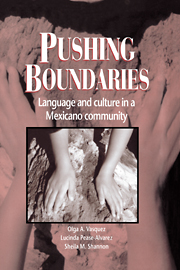Book contents
- Frontmatter
- Contents
- Foreword
- Preface
- Chapter 1 INTRODUCTION
- Chapter 2 EASTSIDE: A MEXICANO COMMUNITY
- Chapter 3 HOME AND SCHOOL CONTEXTS FOR LANGUAGE LEARNING
- Chapter 4 BILINGUAL CHILDREN CROSSING CULTURAL BORDERS
- Chapter 5 NEGOTIATING CULTURE AND LANGUAGE IN THE HOME
- Chapter 6 MOVING TOWARD A RECOGNITION PERSPECTIVE
- Chapter 7 MEETING THE CHALLENGES OF DIVERSITY
- Notes
- References
- Index
Chapter 7 - MEETING THE CHALLENGES OF DIVERSITY
Published online by Cambridge University Press: 26 March 2010
- Frontmatter
- Contents
- Foreword
- Preface
- Chapter 1 INTRODUCTION
- Chapter 2 EASTSIDE: A MEXICANO COMMUNITY
- Chapter 3 HOME AND SCHOOL CONTEXTS FOR LANGUAGE LEARNING
- Chapter 4 BILINGUAL CHILDREN CROSSING CULTURAL BORDERS
- Chapter 5 NEGOTIATING CULTURE AND LANGUAGE IN THE HOME
- Chapter 6 MOVING TOWARD A RECOGNITION PERSPECTIVE
- Chapter 7 MEETING THE CHALLENGES OF DIVERSITY
- Notes
- References
- Index
Summary
Our descriptions of the language practices of Eastsiders contribute to a positive portrayal of the socialization experiences available to a community of learners. The children and adults who engage in the interactions we describe are resourceful participants in a complex and dynamic social milieu. They make optimal use of their social, cultural, and linguistic resources to meet their own needs as well as those of their families and friends. Moreover, as they strive to make sense of an unfamiliar culture and language, they further their own intellectual development in ways that are largely unavailable to monolingual English speakers living in predominantly middle-or upper-class communities.
The following description of Rosalina, an Eastsider, serves as a final metaphor for our work. Although this case depicts an unusual individual, it serves as an example of the kind of student educators might dismiss if they are not mindful of the “hidden” potential behind an apparent incongruity of socioeconomic and family background. Although Rosalina is succeeding as a college student in an institution where few Latinos have succeeded previously, many of the attributes that make her special also characterize other Eastside children.
ROSALINA: CHININA AT BERKELEY
Like many other first generation children, Rosalina Calderon spoke only Spanish when she entered school in the United States. She spent kindergarten through second grade in Mexican schools and in 1978 along with her three older brothers and a sister immigrated to Lincoln City.
- Type
- Chapter
- Information
- Pushing BoundariesLanguage and Culture in a Mexicano Community, pp. 181 - 196Publisher: Cambridge University PressPrint publication year: 1994

